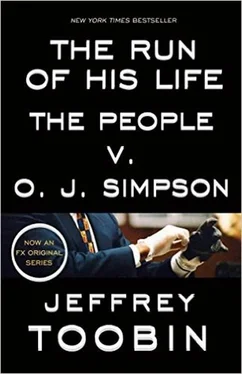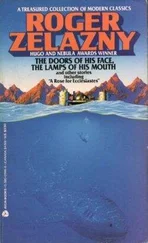In 1967, at the University of Southern California, O.J. Simpson became pope-and then some. He quickly established himself as the best running back in the school’s history on what was perhaps the best team in USC history. He gained 158 yards rushing in his third game and 190 in his fourth. Southern Cal had not beaten Notre Dame in South Bend since 1939, but in 1967 Simpson and his teammates routed the Irish there, 24-7. In the final week of O.J.’s first season, USC played crosstown rival UCLA in a game freighted with even more significance than usual. Both schools, with just one loss each, remained in the hunt for a national championship, and likewise both teams needed only to beat the other to win a bid to go to the Rose Bowl. Finally, the game matched the leading contenders for the Heisman trophy, awarded annually to the best player in the nation-Gary Beban, the senior UCLA quarterback, and O.J. Simpson, the USC junior. Late in the fourth quarter, the game came down to a single play. UCLA led 20-14, and the Trojans had the ball on their own thirty-six-yard line. The drive looked like it would be Southern Cal’s last chance to score. It was third down and eight yards to go.
In the huddle, Toby Page, the USC quarterback, called a play that did not involve Simpson, but he changed his mind at the line of scrimmage and called out, “Twenty-three blast!”-signaling to his teammates that he was calling an audible. In the reconfigured play, Page handed the ball to Simpson, who took off-first right and then back against the grain to the left, all the while trailing UCLA defenders. Simpson outran his own blockers as well as the defense, and his touchdown gave the Trojans the game. Decades later the play remains known to USC faithful as, simply, “the run.” USC went on to beat Indiana in the Rose Bowl, where Simpson was named player of the game, and to win the national championship. (Beban, however, still won the Heisman in a close vote.)
As a senior, Simpson picked up where he had left off. He gained 236 yards in the season opener against Minnesota, 220 against Stanford, and a career high of 238 yards against Oregon State. Southern Cal was tied by Notre Dame in its last regular season game and lost the Rose Bowl to Ohio State, but as a senior Simpson won the Heisman in a landslide. The number of O.J.’s jersey-32-was retired at the end of his career. To be sure, his success at USC was limited to the athletic arena. In those days, before the NCAA began to regulate seriously the recruiting and schooling of college athletes, Simpson received virtually no education at USC. Even today, he can barely write a grammatical sentence. As he confided to Playboy , “My only interest in school was in gettin’ out, so I took courses like home economics, and didn’t exactly kill myself.”
Simpson was the first player selected in the 1969 professional draft and, in a characteristic gesture, parlayed that first year into a book deal as well as a lucrative contract with the Buffalo Bills. OJ: The Education of a Rich Rookie , which was cowritten by Pete Axthelm, is for the most part a stupefyingly dull game-by-game account of the season (“We spent the week working on the I-formation…”), but there are casually revealing moments as well. On the very first page, Simpson wrote, “I have been praised, kidded, and criticized about being image-conscious. And I plead guilty to the charge. I have always wanted to be liked and respected.” In fact, his good looks and cheerful demeanor with reporters and fans paid dividends as soon as he left college.
Before he had played a single professional game, Simpson won endorsement contracts with Chevrolet and Royal Crown Cola, and a broadcasting deal with ABC. “I’m enjoying the money, the big house, the cars; what ghetto kid wouldn’t?” Simpson went on in that first book. “But I don’t feel that I’m being selfish about it. In the long run, I feel that my advances in the business world will shatter a lot of white myths about black athletes-and give some pride and hope to a lot of young blacks. And when I’m finished with the challenges of football, I’m going to take on the challenge of helping black kids in every way I can. I believe I can do as much for my people in my own way as a Tommie Smith, a Jim Brown, or a Jackie Robinson may choose to do in another way. That’s part of the image I want, too.” Simpson had put his views on race more starkly in a 1968 interview with Robert Lipsyte of The New York Times . As the country smoldered with racial tensions-and some black athletes, like Robinson and Muhammad Ali, jeopardized their careers to participate in the civil rights movement-Simpson told Lipsyte, “I’m not black, I’m O.J.”
Simpson’s professional football career started slowly. His first Bills coach, John Rauch, favored a pass-oriented attack, and O.J. did not come close to winning the Rookie of the Year award. He missed most of his second year with an injury. In his third year, the Bills won only one game. But after that season, the owner of the team, Ralph Wilson, made a decision to reorient the entire Bills operation around O.J. Simpson. He fired Rauch and brought in Lou Saban, who favored a running attack. The team began using its draft choices on blockers, building the group that would become famous as the Electric Company-because they “turn on the Juice.” In 1972, the first season under Saban, Simpson ran for 1,251 yards, the best in the league, and his professional career was launched.
Shortly before the next season, Simpson spoke on the phone with Reggie McKenzie, his lead blocker on the Bills. As O.J. recalled it for Larry Fox, he said, “You know, with the guys we’ve got to block, I think I should gain 1,700 yards this year. Maybe I’ll even have a shot at Jim Brown’s [single-season] record.”
McKenzie disagreed. “Why don’t we go for the two grand?”
A 2,000-yard season-something never before done in professional football-became Simpson’s obsession. O.J. gained 250 yards in the Bills’ season opener against the New England Patriots, a new single-game record for the league. As he built his totals with similar performances throughout the 1973 season, football fans followed his race against Brown’s record 1,863 yards and beyond. The hoped-for number had a magical quality. It was one of those round figures that have defined many of sports history’s greatest dramas: the 4-minute mile; the.400 batting average; the 2,000-yard season.
As the year wore on, nearly every story about Simpson noted the contrast between him and Jim Brown. The great Cleveland player, who had been a dour, brooding presence in the game, had churned out his record by crushing everyone in his way, and he was something of a black activist to boot. Simpson relied on speed and agility more than on brute strength. These differences in style, it was said, were reflected in the two men’s temperaments-the militant Brown versus the cheerful Simpson. To the public, Simpson was the anti-Brown, the smiling celebrity, the chipper pitchman, the one who ran around, rather than over, defenders and who never said a discouraging word before the cameras. In fact, these portraits amounted to little more than sportswriters’ tinny conceits, but they affixed Simpson with a glowing image that would last through his arrest for murder in 1994. Simpson did, of course, break the magical barrier in 1973, finishing with 2,003 yards as the nation’s sports fans cheered.
In Simpson’s years as a professional athlete and then afterward, his life amounted to a lesson on the manufacture and maintenance of an image-albeit one that bore little resemblance to the realities of his life. He gave the black community little more than his own example; his charitable activities were minimal. In the seventies, he did a memorable television commercial for sunglasses that ended in a cuddly embrace among Simpson, his wife, Marguerite, and their two little children, Arnelle and Jason. But the marriage-which took place shortly before Arnelle’s birth, in 1968-was a sham. Simpson philandered compulsively, both before and after he met Nicole Brown in 1977, when she was eighteen years old. Nicole had already moved into the Rockingham house when the divorce from Marguerite became final two years later, the year that also marked the end of his football career. O.J. didn’t marry Nicole until she was pregnant with Sydney, in 1985. When he was inducted into the football Hall of Fame that same year, he said Nicole “came into my life at what is probably the most difficult time for an athlete, at the end of my career, and she turned those years into some of the best years of my life.”
Читать дальше












